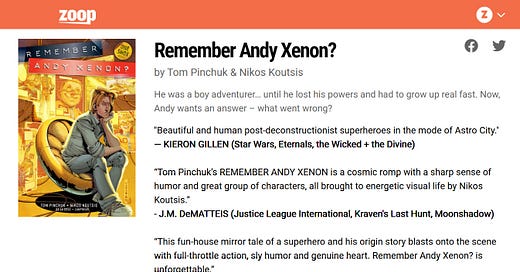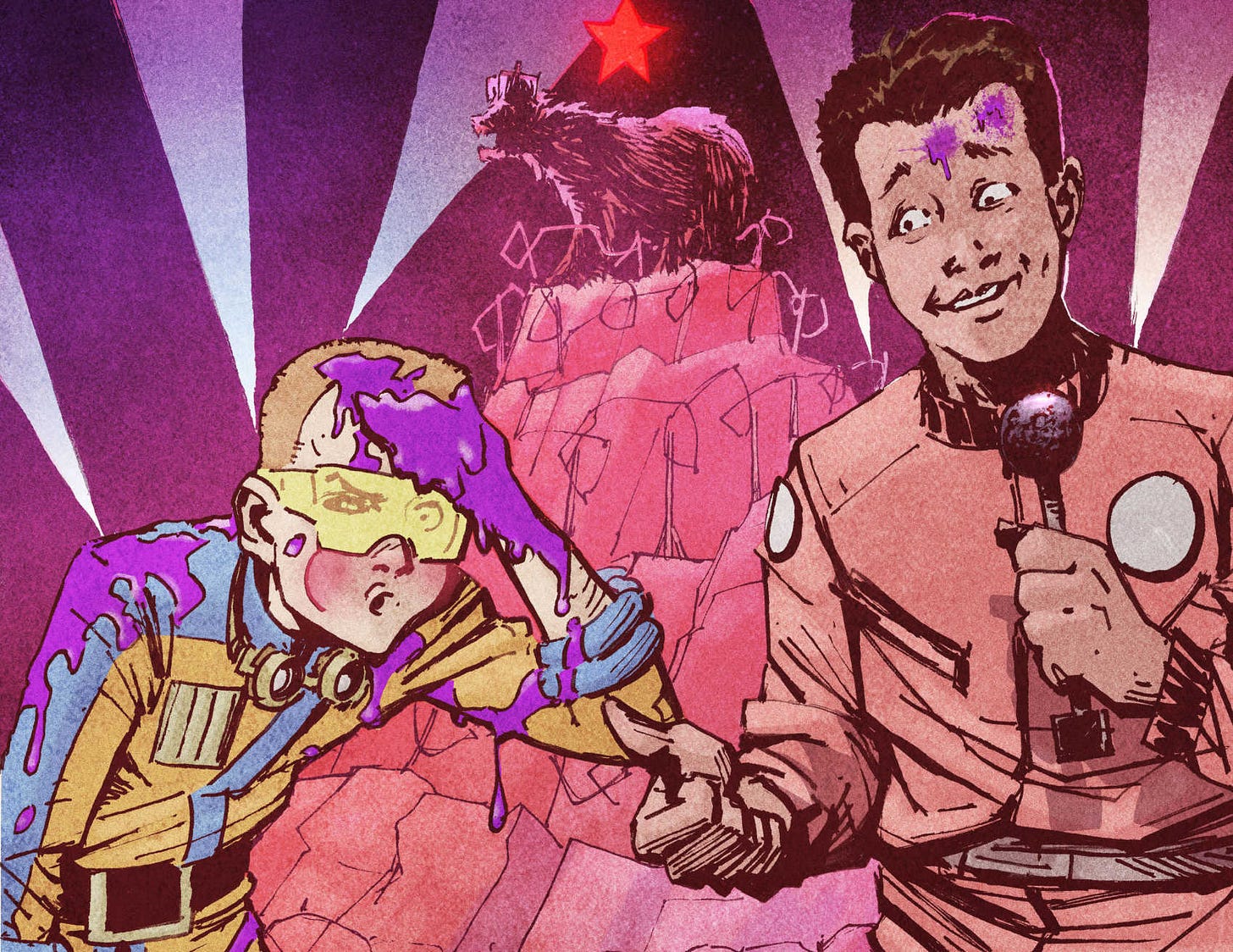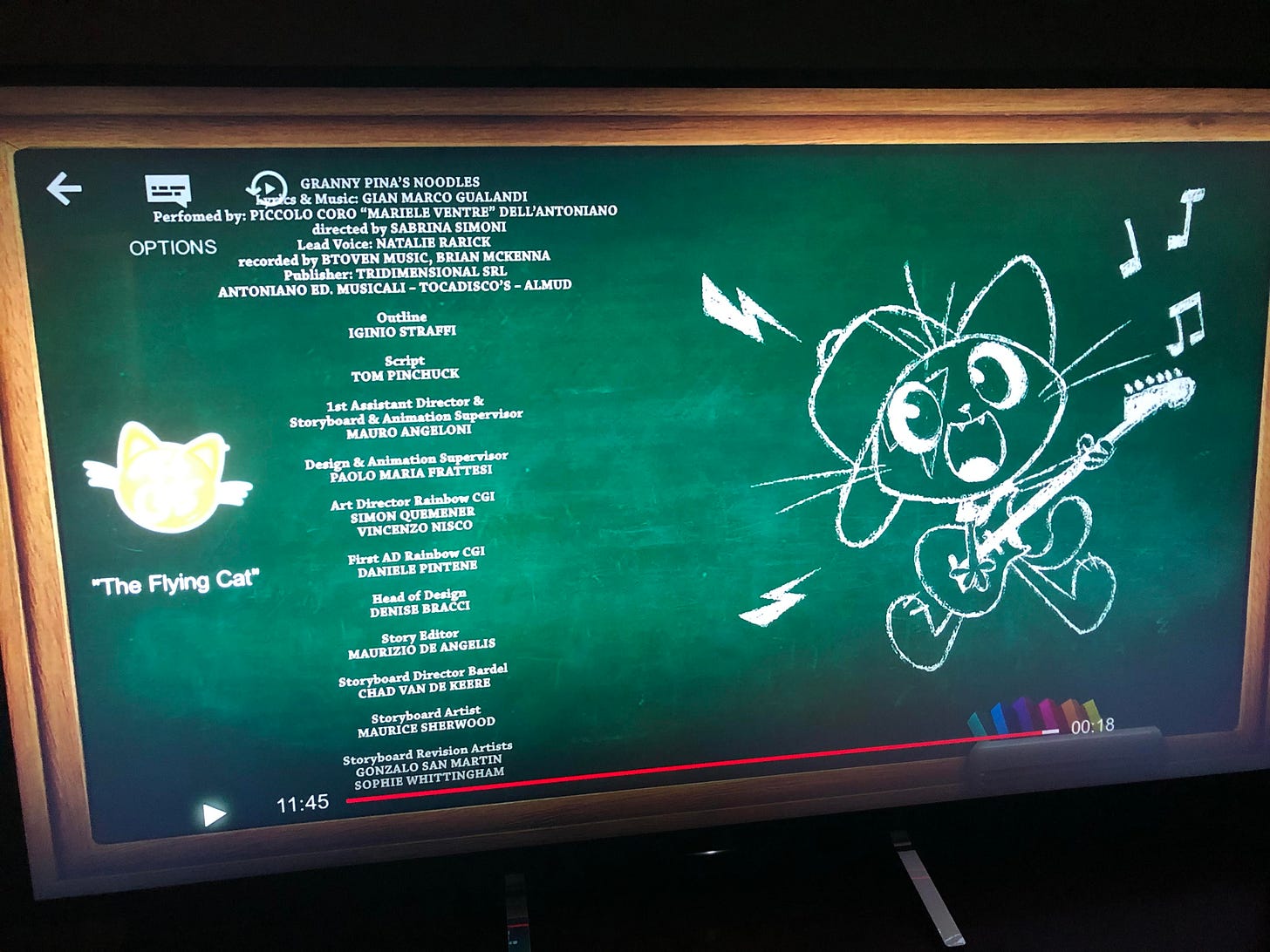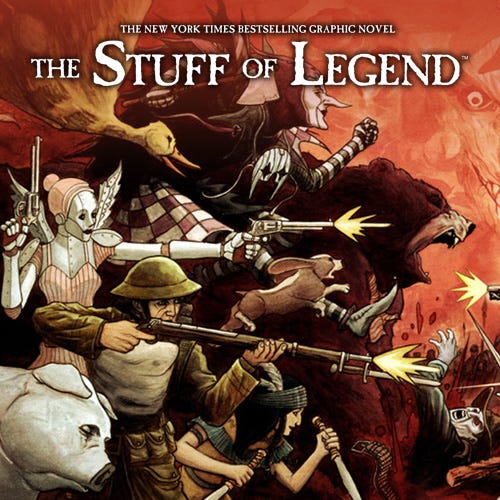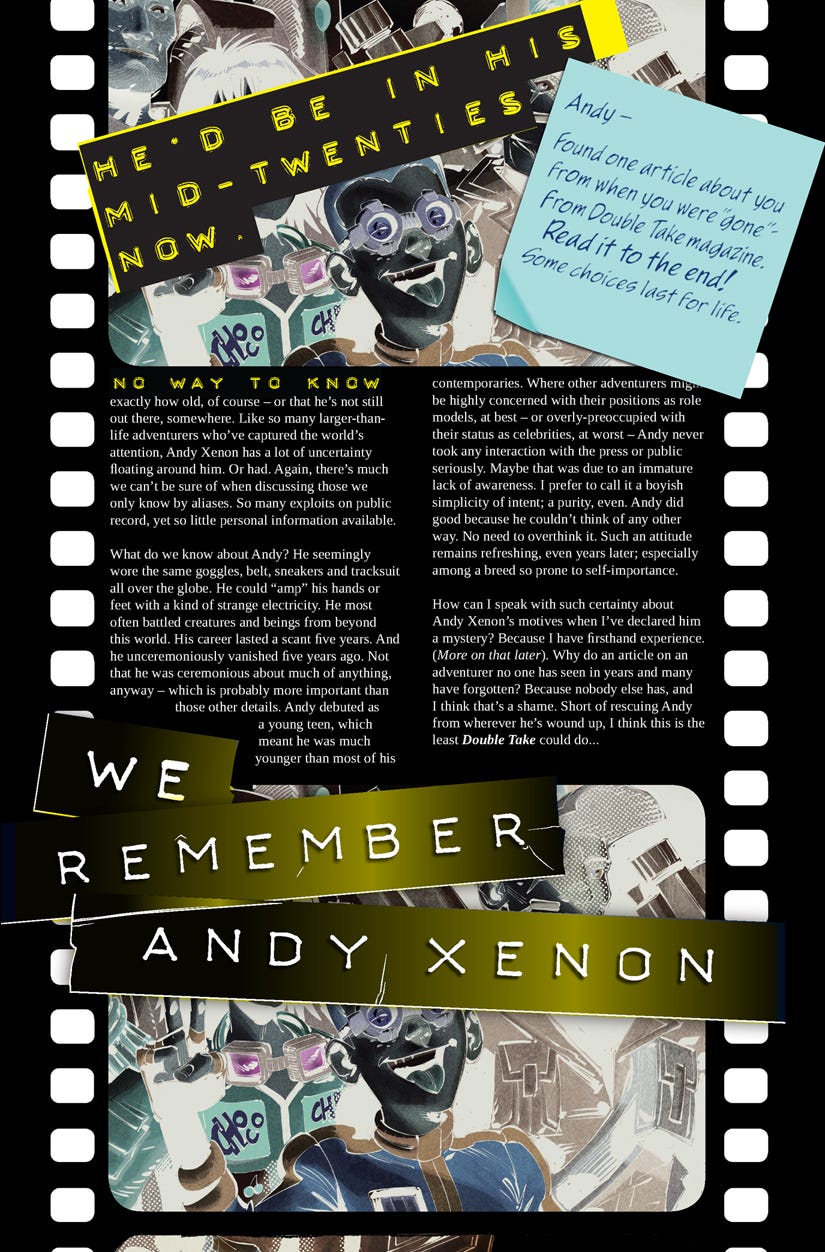As promised last time, Remember Andy Xenon? is now available through Zoop! We’ve put a lot of work and time into the book, and the response it’s been getting from fans and journalists (and even other creators whom I really admire) has been awesome.
Writing’s all about bringing characters from your inner world out to the real one, yeah? Even if I’ve taken this journey before, it’ll never stop feeling surreal – seeing people interact with imaginary friends you’ve been living with for months. I’ve been on a press tour to promote the comic, doing interviews and appearing on podcasts, and it’s been doubly surreal to find so many people get the themes we were reaching for. There’s more on the way, but here’s a collection of what’s up, now…
In a lot of respects, Zoop is a new type of company, so our roll-out’s likewise differed a little from how it’d be if we took a more traditional route. As in, the comic’s only planned to be available through pre-orders on our campaign page at the moment. So, it’s key people know that if they want a copy, they’ve got to order it while the page’s still active. A big plus for anybody getting it through Zoop, too, is the extra goodies and rewards – like original art, commissions, variant covers, the original script, an artist’s edition and even a class I’m teaching. So, many reasons not to wait too long.
As promised last time, too, I can reveal more about our companion piece, “We Remember Andy Xenon,” which is included at the end of the comic. It’s an in-depth in-world magazine retrospective on Andy’s lost adventures, featuring interviews with other adventurers who knew him and hold varying opinions on the guy. Some have theories on why he disappeared. All have their own tragic backstories.
Throughout the article are “file photos” from different eras, each illustrated by a guest artist. I had a wish list of creators I wanted to work with and it was so great to find out they were just as excited to work with me on this. Seeing characters Nikos and I created being interpreted by artists with such a wide variety of styles made those characters feel even more alive. Here’s the gang we assembled…
Alfa Robbi (A.K.A.“Sharknob”) [ MAX STEEL, VOLTRON FORCE]
Enis Cisic [ AVENGERS: MILLENNIUM ]
Joel Gomez [ GEARS OF WAR, THE WORLD ACCORDING TO BATMAN ]
Farid Karami [ LUKE CAGE, NIGHT-GWEN ]
Kevin Castaniero [ GRIT, CAN’T KILL KADE ]
Clay McCormack [ REDLINE, NIGHT MOVES, POSER ]
Patrick McEvoy [ Blizzard, Wizards of the Coast, Marvel Ent. ]
Joe Suitor [ Paramount, Warner Bros. and NBCUniversal ]
Lesley Vamos [ Harper, Walker, Macmillan ]
Charles Paul Wilson III [ THE STUFF OF LEGEND, X-FILES, TMNT]
I was a journalist in another of my past lives, so I was itching to use that style of writing again, doing a Vanity Fair/Wired-esque profile of such outlandish fantasy. Plus, I love the backmatter features in Alan Moore’s comics, like the “Under the Hood” excerpts in Watchmen and “New Travelers’ Almanac” in League of Extraordinary Gentlemen. Something in a similar spirit for Andy Xenon not only felt like a fun creative challenge, but also an effective way to add more verisimilitude to Andy’s world and ground his doomed career in a specific time.
When you read this article, you’ll find many scenes in the main story gain fuller context, or even get re-contextualized – with key revelations changing how you view certain characters. “Self-contained” is what we’re reaching for with the one-shot – giving readers layers of intrigue to discover with each re-read. We were basically able to pack several more books’ worth of plot in.
44 CATS
Speaking of the big worlds, real and otherwise, I wrote an episode of an Italian cartoon, 44 Cats, a while back. Didn't know when or where it'd air, so I put it to the back of my mind. Forgot about it, honestly. Then, last week I saw the show listed on Netflix and – sure enough – "the Flying Cat" is included. A nice, little surprise and it's a fun, little show.
This is probably one of the more minute aspects of a writing career that don’t get talked about much but, in addition to needing to be your own best advocate, you also need to be your own cataloguer, I suppose. With most TV shows (and even more so with an international production like this) there’s no dedicated staffer who’ll inform me about an episode’s status, so it’s on me to find out (and swiftly update my IMDB profile to include the credit). Not sure if I’ll venture into this genre again, but I much enjoyed playing with these cool cats for the time I had.
#PinchukPlug
The latest volume came out last year, but it’s a rare series where “timeless” applies in every sense of the word. Drawn by Charles Paul Wilson III and written Brian Smith and Mike Raicht, the Stuff of Legend finds such pathos in playthings. I’ve relished every chance to revisit its world.
The adventure starts when a boy is kidnapped by the Bogeyman, and his toys marshal together to rescue him. The elevator pitch I’ve given to friends is “Lord of the Rings meets Toy Story by way of David Lynch,” but that still does disservice to the execution. I love how the comic so precisely balances atmospheric surrealism with concrete stakes. There’s a dream logic to the premise which gets more engaging as the toys explore all its implications in the pocket world. Different types of toys form different factions, and they play for keeps in some truly nightmarish parts.
My favorite chapters are when the toys exhibit very human foibles, with some even betraying their cause (for actually rather understandable reasons). Later chapters even find some sympathy for the devil by revealing the Bogeyman’s background and his surprising motives for seizing the boy.
Every aspect of the presentation has been thought out to enhance the mood, too. Pages are square-formatted, with sepia tones and rendering by Charles that evoke the etchings in classic lit. It all works together to make this feel like a dusty storybook unearthed at some haunted antiques store. I was so lucky I could entice Charles to contribute one of the illustrations in “We Remember Andy Xenon.”
TIPS & TRICKS
I put an offer out before: I’d love to answer fan mail here, or any questions about writing. The offer’s still good, so feel free to shoot me an e-mail. Justin here gets to be first, now, with a pointed question about exposition…
“I love world-building in stories, but often when I see advice about writing, I get told to not get into any of that. It’s exposition, it’s boring, etc. But I keep seeing examples in what I watch and read. How come they get away with it?”
Justin Rivers — Schenectady, NY
I’ve had the same confusion. When I was learning to write, I found some cliché advice really didn’t correlate to what I actually enjoyed as a reader/viewer. I chalk this up now to how people just love a snappy precept, even if it over-simplifies things. Anyway, one such notion was that exposition is the enemy and you must always avoid narration at the start of your story.
Well, again… as you also found, this was at odds with what I’d seen and enjoyed. Fellowship of the Ring, Road Warrior, Conan the Barbarian, Star Wars… all massive hits that start with narration in one form or another. Iconic narration, at that. With fantasy, there’s also a pressing, practical concern of the audience needing to be quickly appraised of jargon and other particulars of a world. I’ve seen movies skip this part entirely and suffer for it. Withhold explanations and there’s real threat of the audience being lost and confused.
Now, I’ve also seen countless mind-numbing, momentum-killing and enthusiasm-dampening “info dump” intros, too. Believe me. But as with anything, there’s a right way to do it and a wrong way.
I’ve found a useful compare/contrast in Terminator 2 and the first Dune movie. Lynch has pretty much disowned the latter. There was even an infamous TV version he took his name off of because, among other things, the producers re-did the intro in attempt to explain things better.
Let’s just look at the theatrical cut, though. It’s simply Princess Irulan starring at the audience. Dispassionately describing this future galactic realpolitik. Expressing no personal investment in it, not even when she mentions her father. There’s a lot of jargon to keep track of, from the Spice Melange to the Spacing Guild, and even more to grok in the next scene, which is another dry info dump. Visual aides of the alien planets help, yes, but they accompany a bureaucratic memo read aloud by an emotionless robot voice. Political treachery is discussed but, once more, the speaker has no feeling about it.
T2 opens with Sarah Connor addressing the audience, too, but you can hear this haunted dread in her voice. She mourns this future’s catastrophic loss of human life, and summarizes the first movie in a sentence, repeatedly stressing her personal connection to it all. There are basically only two bits of jargon to keep track of, and what Sarah describes is continually illustrated by dire, dramatic imagery. Skulls crushed by tank treads! Soldiers gunned down by killing machines! Stakes are very explicitly stressed by the elegiac comparison of a playground where children swing about and one in the future that’s bathed in fire and littered with skeletons.
“We Remember Andy Xenon” isn’t precisely the same thing, but world-building is one big aim, of course. While I was crafting it, I looked at a lot of backmatter features and tried to dissect where they worked or didn’t. I reached the same conclusion I did about opening narration: even if the purpose is mostly to chart a fictional world, it still needs to have some investment of emotion and personality. Even the World of Ice and Fire (which is more-or-less marketed as a Game of Thrones history textbook) subtly stresses it’s the work of an imperfect historian who can’t help but make personal asides and continually harp on the human drama of the lords and ladies he chronicles.
Anyway, while our piece has the feel of a formal article, I kept the focus always on the foibles of the adventurers being profiled, and also dangled some intrigue about why the author’s writing it in the first place. Don’t want to say too much, but she winds up having a deeply personal reason for trying to find out whatever happened to this forgotten kid hero – and that’s not by accident.
I’ll be sharing more Tips & Tricks in future Chuk Chronicles. If you have any writing questions, thoughts on my work, or bon mots, shoot me a message. You might get answered here! Next time, I’ll talk about another book I’ve written that dives just as deep into a fictional world. Though, a much wackier one.

